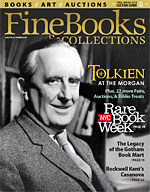For the Birds
To the surprise of nearly everyone involved, Jenkins received another phone call from Hoffman a week later. The caller offered to bring the items to Jenkins in Texas, but Jenkins decided to meet the man in New York the next day, July 13. They agreed to a rendez-vous at Kennedy Airport to work out details of the sale. Jenkins immediately called Agent Chapman of the FBI, who hurriedly arranged a task force to handle the operation. Smoking a “bright orange pipe” so he would be recognized by the FBI, Jenkins exited his plane and met Hoffman, all the while under surveillance by Bureau agents.
From here on, the narrative of events is best quoted directly from Jenkins, taken from a letter he wrote to Dr. Tolan the next morning.
Then began a bizarre and frightening, albeit exhilarating day for this young bookman, to say the least. We careened out of the airport often making several u-turns and with Mr. Hoffman continually looking out the back mirror. Satisfied, he took me to a rather disreputable motel near the airport. We entered Room 209 and there on the bed I saw two stacks of Audubon plates. I examined them closely, disappointed to find that there were only about 25 of them in all, and elated that the turkey and eagle plates were among them. I examined the books and manuscripts, which looked like those described as stolen from Mr. Shapiro, and after some rudimentary bargaining, agreed to pay thirty thousand for the whole lot. I stipulated, however, that I would have to examine all hundred of the plates first. We agreed that I would go to my hotel ‘to call my banker in Austin’ and that when I returned at 5:30 he would have all the ‘merchandise’ for me to see. He took me to my hotel and I called my associates at the FBI. We returned to his hotel at 5:30, I knocked on the door, and when he opened the door we entered and he was arrested. In the car trunk were all the Audubon plates and some of the books. He was apparently about to leave, as his bags were in the car and all the plates, instead of being in the room as he had promised. So we were, as in all dramatic detective thrillers, in the nick of time.
The Birds were returned to Union, and brilliantly conserved by Carolyn Horton Associates of New York City. Traces of blood (“mud,” Hoffman had told Jenkins) were removed, and rips to various plates were repaired. Since 2006, after undergoing conservation work at the Northeast Document Conservation Center, all 435 plates have returned to a rotating display in Schaffer Library.
Kenneth Paull, alias Carl Hoffman, John Galt, and several other monikers, was a 39-year-old ex-convict, paroled from a Pennsylvania prison shortly before the theft (he’d been serving time on a bank robbery charge). Along with Union’s Audubons, 26 other stolen rare books and two loaded guns were discovered in the trunk of his car, which was registered to R.P. Heffin (an alias used by Ronald Ravich, who had escaped from prison while serving a 25-year sentence for robbery). Paull was never prosecuted for the burglary but was returned to a Pennsylvania correctional facility for a parole violation.
Jenkins claimed the $2,000 reward from Union and then presented it to the college in the form of an annual award for bibliography (discontinued after 1981). He was awarded with the Founders’ Medal in 1973 and an Honorary Doctorate of Literature in 1976. He also served as a trustee of the college from 1977 through 1979. Largely due to his role in the Audubon events, Jenkins was named the first Antiquarian Booksellers’ Association of America security officer and was later elected president of the organization.
Within a few short years, however, Jenkins’ career took a sharp dive, when he was accused of selling forgeries of historical Texas memorabilia. He turned his “Audubon caper” into what the New Yorker later called “a bullet-sprayed, blood spattered adventure so gripping that it was in fact the basis for an episode of ‘Kojak.’” A fire at his shop in 1987 (the second in five years) was ruled an arson, and Jenkins was widely suspected for the crime.
Then, on the evening of April 16, 1989, a fisherman discovered Jenkins’ body, which had caught in the branch of a cottonwood tree in the Colorado River near Bastrop, Texas. According to an article from the Maine Antique Digest, Jenkins “had been shot once on the right side of the back of the head by a large caliber handgun.” His car was discovered parked on a nearby bridge, the passenger door open. Jenkins’ watch was missing, and his wallet was discovered empty nearby. No gun was ever found. At first, murder was the assumed cause of death, but evidence has emerged which might serve to suggest otherwise.
County Sheriff Con Keirsey believed that Jenkins’ death was suicide. He claimed that the bookseller was aware that an indictment for arson was forthcoming. His business was a wreck. He had reportedly spoken with friends and family members about ways to fake a murder scene and commit suicide (so as to collect insurance). His hypothetical scenario exactly matched the scene of his death, right down to the emptied wallet. Was it murder, though? Did one of Jenkins’ bilked buyers hunt him down? Or did Union librarian Edwin Tolan prove prescient when he warned Jenkins in 1971 to be wary of the Audubon thieves? We may never know the answer. Regardless of his later activities, though, Jenkins remains in high esteem to those of us connected with Union College, for his role in returning our missing Birds of America.








 Jeremy Dibbell, an assistant reference librarian at the Massachusetts Historical Society in Boston,
Jeremy Dibbell, an assistant reference librarian at the Massachusetts Historical Society in Boston,